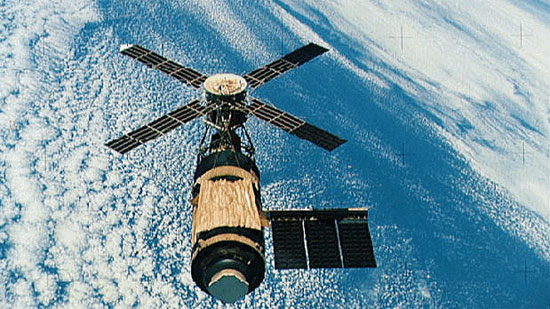NASA celebrates 40 years of the first space station project
On May 10, the US Space Agency (NASA) celebrated the 40th anniversary of the US launch of the first space station to space - Skylab.
NASA launched the Skylab space station on May 14, 1973, followed by three Skylab crews working permanently on the station. Knowledge from Skylab played a decisive role in the development and construction of the International Space Station (ISS) later.
1. Skylab is an ambitious space program designed to test all aspects of a very important issue that until then has not been proven in space science: whether humans can live one Long time in orbit around Earth?
However, Skylab ended up bringing more. It helped conduct the first large-scale study of the Earth's crust, one of the first comprehensive studies of the Sun, to observe comets at closer distances .
2. George Mueller's Skylab sketch drawing, co-curator of the manned space program, NASA, at that time. This sketch was made during a meeting at Marshall Space Center on August 19, 1966. In 1970, the space station was named Skylab. Skylab's first three manned missions were carried out (Skylab 2 in May 1973, Skylab July 3, 1973 and Skylab November 4, 1973).

Knowledge from Skylab has played a decisive role in
the development and construction of the International Space Station (ISS)
3. Skylab texture and detailed drawings.
4. Launched with Saturn V missiles during the development of Apollo cruise ships on May 14, 1973, Skylab was the first US space station, unmanned. The station almost immediately had technical problems immediately after taking off due to a meteor shower that occurred just in time for it to enter orbit, damaging one of the space station's two main solar panels.
5. On May 25, 1973, the first manned mission, with astronauts Charles Conrad Junior (commander), Paul J. Weitz (pilot) and Joseph P. Kerwin (pilot cum scientist ), launched into orbit after the experience of previous launches, including installing a shield to reduce the temperature inside the cockpit to 75 degrees F (23.9 degrees C). The space station is fully operational from June 4.

Skylab sketch drawing by George Bueller
6. Astronaut Owen Garriott has an Apollo telescope space walk (ATM) belonging to Skylab space station on Earth orbit. Garriott recently conducted a specimen collection experiment for Skylab with the aim of collecting cosmic dust to study correlation phenomena, according to NASA.
7. Skylab is designed to maximize solar bars towards the sun to provide as much electricity as possible. But due to the lack of a shield, the chamber temperature increased to 52 degrees Celsius. The Skylab 2 launch was therefore postponed so that NASA engineers conducted 10 days of hard work to develop a shield to reduce energy. in the cabin, creating a more suitable working environment for astronauts.
8. During the Skylab test, Conrad reported: 'The solar wing No. 2 was completely broken, the number 1 wing was partially deployed'. He also reported that pieces of cosmic trash caused by meteor shower still surround the energy bars, making it impossible to fully operate.
9. Usually, Skylab flies with energy bars heading straight towards the sun. After the shield was lost, the controller from the ground adjusted the direction for the space station to have 45-degree energy bars facing the sun. The energy bar operates less efficiently, but the temperature in the chamber will not be too high, according to NASA.

Skylab texture and detailed drawings
10. The temperature of all equipment during the operation of the space station is strictly controlled.
11. Orientation in the space station is not a problem. When the astronauts adapted to the new environment, scientist and pilot Kerwin announced everything normally.
12. Twenty-two titanium spheres contain nitrogen gas required for operating the control system.
13. The space station's solar wings are those that are attached and stacked on top of each other, each consisting of hundreds of pieces, according to NASA.
14. The two IBM computers in Skylab control the direction of the space station during the mission. Space station computers are IBM System / 4Pi models, designed specifically for weight and according to the requirements of the cosmic environment. Each IBM machine on Skylab weighs 100 pounds and measures 19 x 7.3 x 31.8 inches (48 x 18.5 x 80.8 cm). They can handle more than 100 signals to Skylab.
15. Commander Skylab 2 Pete Conrad was checked by Joseph Kerwin in the space of the space station.
- NASA wants to sell ISS space station in the next 10 years
- NASA built a space station in the middle of the moon
- NASA gives ISS another 4 years of operation
- NASA once owed $ 400 for 30 years to pay
- Overview of China's Thien Cung 1 Space Station
- Russian space station will replace the US ISS global surveillance
- International space station is 10 years old
- NASA opened the International Space Station for ... tourists and film makers from 2020
- The uncertain future of the ISS space station when NASA returns to the Moon
- How much does NASA pay for each ticket to space?
- Russia plans to shorten the operational duration of the ISS station
- NASA has just revealed an exciting plan from now until 2030
 Van Allen's belt and evidence that the Apollo 11 mission to the Moon was myth
Van Allen's belt and evidence that the Apollo 11 mission to the Moon was myth The levels of civilization in the universe (Kardashev scale)
The levels of civilization in the universe (Kardashev scale) Today Mars, the sun and the Earth are aligned
Today Mars, the sun and the Earth are aligned The Amazon owner announced a secret plan to build a space base for thousands of people
The Amazon owner announced a secret plan to build a space base for thousands of people